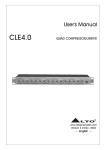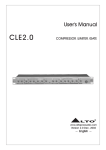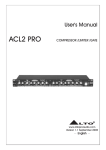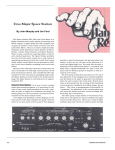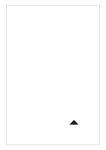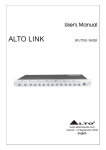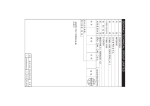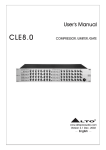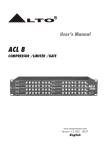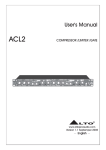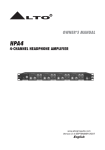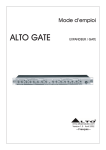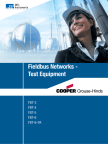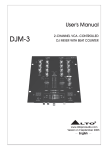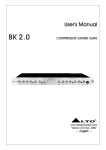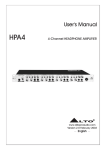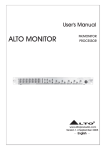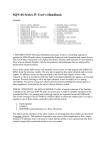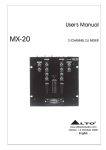Download user`s manual - Topp Pro Professional Audio Gear
Transcript
A3 A4 A5 NH00149 2:1/NH00231 1:2 TCL-2 0.072KG/1 TCL-2 TOPP PRO_V1.0 -RS NF03520 TOPP PRO SEIKAKU TECHNICAL GROUP LIMITED 18 NPD-TO-1008001 9PCS JAN.06.2011 TCL TCL-2 THRESHOLD GAIN REDUCTION(dB) 30 27 24 21 18 15 12 9 0 SC EXTERANL 35 2.5 60 0 7 1.5 6 4 INPUT / OUTPUT LEVEL(dB) 24 18 12 1 2 6 0 30 30 4 +10 10 2 0.3 15 70 1 150 6 110 0.5 0.1 3 +10 10 THRESHOLD GAIN REDUCTION(dB) 30 27 24 21 18 15 12 9 0 SC EXTERANL CH1 0 1.5 LIM 6 12 18 SMART 10 35 +12 +18 +4 2.5 60 0 7 1.5 6 4 INPUT / OUTPUT LEVEL(dB) 24 18 12 1 2 6 0 30 30 4 +10 10 2 0.3 15 70 1 150 110 6 0.5 0.1 CH2 0 1.5 LIM 6 12 18 SMART 10 +12 ON 3 10 +10 +15 OFF dBu 8 1.2 40 +20 dBu 1:N SC MONITOR THRESHOLD RATIO EXPANDER / GATE NF03520-1.0 THRESHOLD 1 N:1 SC FILTER RATIO dB/mSec ATTACK 5 0.05 MANUAL AUTO COMPRESSOR 20 +20 dB dB/Sec I/O METER RELEASE OUTPUT GAIN 0 BYPASS COMP OFF dBu THRESHOLD LIMITER +15 OFF DUAL MONO CH 1 MASTER COUPLE dBu 8 1.2 40 +20 dBu 1:N SC MONITOR THRESHOLD RATIO EXPANDER / GATE THRESHOLD 1 N:1 dB/mSec SC FILTER RATIO ATTACK 5 0.05 MANUAL AUTO COMPRESSOR 20 +20 dB dB/Sec I/O METER RELEASE OUTPUT GAIN 0 BYPASS COMP OFF dBu OFF THRESHOLD LIMITER TCL-2 COMPRESSOR/ LIMITER/GATE +18 +4 R POWER TABLE OF CONTENTS 1. INTRODUCTION......................................................................................................................................4 2. THE CONCEPT BEHIND........................................................................................................................ 4 2.1 Some technical stuff 2.2 Voltage Controlled Amplifier (VCA) 2.3 Inputs 3. CONTROLS........................................................................................................................................6 3.1 Expander/Gate Section 3.2 Compressor Section 3.3 Peak Limiter Section 3.4 Connectors on The Rear Panel 4. READY TO ROLL?.................................................................................................................................10 4.1 Expander/Gate Section 4.2 Compressor Section 4.3 Peak Limiter Section 5. INSTALLATION AND CONNECTION.....................................................................................................12 5.1 Mains Connection 5.2 Audio Connection 5.3 Rack Mounting 6. TECHNICAL SPECIFICATIONS ................................................................................................................................ 15 7. WARRANTY .......................................................................................................................................................... 17 INTRODUCTION You are now the Owner of an TOPP PRO TCL-2 Compressor/Limiter/Gate. The TCL-2 is a very powerful dynamic processor. We have included in it with several innovative circuit designs that make the ATCL-2 a very versatile processor: smart and fast recognition of the program, adjustable Expander/Gate and very low distortion Voltage Control Amplifier (VCA). Feature List: Smart Knee Control Compressor (SKC) Soft knee or hard knee? This is the question! SKC combines both: In the "soft knee" mode you control the program material so that the compression will be the most musical and inaudible. On the other end, the hard knee function is used for better precision, limiting signal peaks with precision and will allow you to add creativity to the dynamic processing. This function also allows you to protect other equipment in the signal loop against distortion. The AUTO Function Your TCL-2 includes AUTO function switch on the front panel. Thanks to the AUTO function attack and release times of the program materials are automatically analysed. Then the dynamic range of the program is heavily compressed in a very musical way so that there will not be any audible breathing or pumping effect. Attack and Release Controls: Ok,Ok, you do not want to get advantage of our AUTO function and be the Master of your own mix. We have provided your TCL-2 with User Adjustable attack and release time for the best total manual control. Smart Ratio Control expander (SRC) During music pauses or when a quiet session occurs, the noise floor maybe highly amplified and this effect may be exaggerated because of inappropriate use of the expansion ratio. The SRC control will adjust the expansion depending on the input signal so that those signals, which are slightly above the noise floor level, will get the major benefits. Smart Gain Control peak limiter (SGC) This function includes two important functions: Clipper and program limiter. The peak limiter will be activated above a certain threshold that is adjusted by the User and will radically restrict signal peaks. But what about if the threshold of the Limiter is surpassed only for a few milliseconds? SGC will turn on automatically and reduce theoutput signal so that you will not hear any distortion. Smart, isn't it? The SGC proves to be very efficient in loud-speaker protection and to reduce undesired peaks in digital situations. THE CONCEPT BEHIND Some technical stuff Good old analog technology: It will allow us to manufacture audio equipment with a very high dynamic range: up to 125 dB. But the dynamic range of digital equipment is more or less 25 dB. A further reduction in dynamic range occurs with the use of tape recorders and/or vinyl records. It is not just Music Yes, a piece of electronic will produce some noise. When the current flows through a conductor this will generate a certain movement of the electrons and therefore: noise. And throughout the whole spectrum of audio. Imagine what happens when this inherent noise will be amplified. Yes, today one can use "low-noise" components but still such components will present a certain level of residual noise. For example with tape recorders it will not be possible to get an S/N (signal to noise) ratio better than 70dB. This level would not be accepted today by the increased sensitivity of the listeners. It is possible to improve the performance of a tape recorder: Absolutely no! 4 Introducing Audio Dynamics The human ear can detect the noise generated by falling leaves as well as the roar generated by the taking off space shuttle. Unfortunately no analog, nor digital device can reproduce such wide spectrum. Please look at Chart.1 and you will see the difference when dynamic capacity of various devices compare to the human ear. More problems occur when handling high level signals and low level signals. When you reach the high level limit you may incur in distortion because of the dynamic range of the instrument therefore a certain "reserve" must be maintained to avoid distortion. This reserve is known as "headroom" and it is usually set at 10-20 dB. Would not be easier just to reduce the operating level? Yes it would but you would put low level music signals at the same level of the basic noise floor so the overall quality of the signal would be highly deteriorated. Please look at Chart. 2 and note the Usable dynamic range (including headroom) versus high level distortion generated by peaks, and Noise floor level. Chart. 1 The dynamic range capabilities of various devices Clipping Aera Noise Aera Clipping Signal heavily distrorted Low level signal drowned out by noise Chart. 2 The interactive relationship between the operating level and the headroom So the operating level must be as high as possible but not high enough to generate distortion. There is a very easy way to obtain this. With the volume knob in hand you can increase the volume during low passages and decrease the volume during loud passages. Unfortunately even the Great Houdini would not be fast enough to monitor carefully the speed of the musical signal and it would be impossible to detect signal peaks and consequently levelling them out. Manual control is therefore out of question. The answer is AGC (automatic gain control); a device that will monitor the signal in real time and that will adjust the gain for the best S/N ratio without producing distortion. So, the name of this device is "Compressor/limiter". More technical stuff about Compressor/Limiters Try to measure the dynamic range of musical instruments. You will find out that your ear will handle such range during which the distortion and overloading will be generated in your audio equipment. To avoid these, compressor/Limiters will be used. Both Compressors and Limiters more or less do the same job but Limiters brutally limit the audio signal above a set threshold, while Compressors handle signal in a much more civilised way and over a wide range of levels. If an audio signal exceeds the threshold set by the User the limiter will kill any audio signal above that threshold. Period! Also Compressors perform their function when the audio signal exceed a certain threshold but the signal is not killed brutally. The audio signal will be reduced in gain in proportion with the amount above the set threshold. 5 More about noise: Expanders and Noise-Gates A lot of instruments such as microphones, amplifiers, guitar pickups, etc generate some noise, either at low frequencies (hum) or at high frequencies (hiss) such noise will inevitably interfere with the quality of your audio signal. Now, if you scream into a microphone you will not hear the noise generated by such microphone because such noise will be "masked" by the higher level of the signal, your voice in this case. But if you sing into your microphone more gently in a soft passage, the level of the signal generated by your voice will get much closer to the floor noise level and such floor noise will become disturbing. In order to kill this problem Expanders and noise-gates are used. An expander is the opposite of a compressor: attenuating the signal when the amplitude drops they can limit the floor noise. Now, we do not need dramatic expansion of a signal across the range, This would generate a resulting dynamic range of over 150dB. For this reason the amplitude control will be applied only to those audio signals which are below a set threshold. Those audio signals above the set threshold will not be affected. Noisegate can be regarded as a simple Expander. But the Expander will attenuate the audio signal continuously below the set threshold while the noise-gate will simply dramatically cut-off the audio signal completely. Voltage Controlled Amplifier (VCA) The VCA is the soul of the TCL-2 and it is one of the best components available today in his category thanks to its excellent performances in terms of distortion, linearity, noise and temperature stability. Inputs Take it easy: Balanced Inputs To make your life easy and clean we have provided TCL-2 with electronically balanced inputs. Even if you operate at high signal levels, hum and noise will be reduce automatically. There is also a servo-function that will automatically adjust the internal level when unbalanced connectors are detected. The correction if of 6dB and it will avoid differences in level in between input and output signal. CONTROLS THRESHOLD GAIN REDUCTION(dB) 0 30 27 24 21 18 15 12 9 SC EXTERANL 35 2.5 60 0 7 1.5 6 4 INPUT / OUTPUT LEVEL(dB) 24 18 12 1 2 6 0 30 30 4 +10 10 2 0.3 15 70 1 150 110 6 0.5 0.1 3 10 +10 GAIN REDUCTION(dB) 0 30 27 24 21 18 15 12 9 SC EXTERANL CH1 0 1.5 THRESHOLD LIM 6 12 18 SMART 10 35 +12 +18 +4 2.5 60 0 7 1.5 6 4 INPUT / OUTPUT LEVEL(dB) 24 18 12 1 2 6 0 30 30 4 +10 10 2 0.3 15 70 1 150 110 6 0.5 0.1 CH2 0 1.5 LIM 6 12 18 SMART 10 +12 ON 3 10 +10 +15 OFF 40 8 1.2 dBu 1:N THRESHOLD RATIO +20 dBu SC MONITOR THRESHOLD 1 N:1 SC FILTER RATIO EXPANDER / GATE dB/mSec ATTACK 5 0.05 MANUAL AUTO COMPRESSOR 20 +20 dB dB/Sec I/O METER RELEASE OUTPUT GAIN 0 BYPASS COMP OFF dBu THRESHOLD LIMITER DUAL MONO CH 1 MASTER 8 1.2 +15 OFF dBu 1:N THRESHOLD RATIO 40 +20 dBu SC MONITOR COUPLE 1 N:1 dB/mSec SC FILTER THRESHOLD RATIO EXPANDER / GATE ATTACK 5 0.05 MANUAL AUTO COMPRESSOR 20 +20 dB dB/Sec I/O METER RELEASE OUTPUT GAIN 0 BYPASS COMP TCL-2 COMPRESSOR/ LIMITER/GATE +18 +4 R OFF dBu OFF THRESHOLD LIMITER POWER 13 Pic. 1 Front Panel of The ACL2 PRO Your TCL-2 presents with right and left channels. Each channel is equipped with the same control elements: 7 pushbutton switches, 8 rotary controls and 26 LEDs. You can easily operate the stereo mode via pressing the Couple switch. The details please refer to following content. 1. Couple Switch Pressing this push-button for stereo mode operation. When engaged, the Master channel (channel 1) will take control of both channels and override all the controls and switches of channel 2 with the exception of the SC Monitor, SC External, SC Filter and Bypass switches as well as the Peak Limiter control. 4 Expander/Gate Section -35 2.5 1.5 -60 7 0 +15 OFF dBu THRESHOLD 8 1.2 1:N RATIO EXPANDER / GATE 2 6 3 Pic. 2 Controls of Expander /Gate section 2. Threshold Control This control adjusts the threshold level for the Expander / Gate Section in the range of Off to +15dBu. Signals below this level cause expansion. 3. Ratio Control This control determines the expansion ratio when the signal drops below the threshold level. The expansion ratio can be set from 1:1.2 to 1:8 (Low ratio for Expander application or 1:8 for Gate application). 4. Threshold LED The "+" Led lights up when an audio signal is below the set threshold. The "-" Led lights up in presence of an expansion Compressor Section 12 15 6 19 THRESHOLD GAIN REDUCTION(dB) -10 -24 -18 -12 -6 0 SMART 30 4 -30 +10 10 6 2 +20 SC FILTER dBu THRESHOLD 70 1 150 dB/mSec ATTACK 3 -10 +10 5 0.05 MANUAL AUTO CH2 1.5 0.3 110 0.1 1 N:1 RATIO 6 12 18 0 0.5 15 -40 SC MONITOR INPUT / OUTPUT LEVEL(dB) 30 27 24 21 18 15 12 9 6 4 2 1 0 SC EXTERANL 18 dB/Sec RELEASE +20 I/O METER dB OUTPUT GAIN BYPASS COMP COMPRESSOR 13 5 14 7 8 10 9 17 11 16 Pic. 3 Controls of the Compressor Section 5. Threshold Control This control adjusts the threshold level for the Compressor section in the range of -40dBu to +20dBu. The SKC (Smart Knee Control) is applied to the audio signal, which is a maximum of 10dB above the set threshold. Above such level (10dB) a hard knee compression will be applied. 6. Threshold LED These LED's will show you the state of the input signal in relation to the threshold level. If the input signal falls below the set threshold level the left "-" LED will light up. This means that no signal is being compressed. If the input signal rises above the set threshold level, this signal will be compressed and the SKC level will be shown by the middle "0" LED. 7. Ratio Control The ratio between the input and output level of audio signals exceeding the set threshold level is determined by this control. This control is manually adjustable from 1:1 to :1. 8. Attack Control This control determines how fast the compressor is to respond to audio signals that will exceed the set threshold. It can be manually adjusted from 1 to 150 ms. 9. Release Control This control determines how fast is the compressor to return to unity gain when the audio signal falls below the set threshold level. It can be manually adjusted from 0.05 to 5 seconds. 10.Auto Switch Who needs attack and release control? Activate this switch and these controls will be deactivated. Attack and release controls will be automatically set by the unit depending on the program material. 7 11. Output Gain Control Through this control you can vary the output signal by a maximum of 20dB. In this way you can recover the level lost during the compression process. 12. SC External Switch This switch will sever the connection between the audio input and the sidechain path. But at the same time it will also allow an external signal through the SC return jack present on the rear panel. 13. SC Monitor Switch You can connect the sidechain control signal to the audio output by mean of this switch and at the same time you will also mute the audio input. In this way you can also monitor the sidechain signal being returned via external signal processors. 14. Sidechain Filter Switch A low-cut filter in the sidechain path is activated by this switch. This eliminates unwanted noise generated by low frequencies. 15. Smart switch Hard knee mode will be converted into SKC mode by mean of this switch. If you want to get a very musical compression and you wish to get the most inaudible compression, use SKC. 16. Bypass Switch This switch simply turns off the correspondent channel. It can also be used to make an A/B comparison in between processed and unprocessed signal. 17. Input / Output Meter Switch When the switch is ON it will read the input level. When it is OFF it will read the output level. 18. Input / Output Level Meter It will read the actual Input or Output Level. The range goes from -24dB to +18dB. 19. Gain Reduction Meter It indicated the gain reduction. The range displayed is 1 to 30 dB. Peak Limiter Section 21 LIM +12 +4 +18 0 OFF dBu THRESHOLD LIMITER 20 Pic. 4 Controls of the Peak Limiter section 20. Threshold Control The threshold level of the Peak Limiter is adjusted by this control. 21. Limiter LED This Led will light up when the Limiter function is activated. 8 Connectors on The Rear Panel 22 AC INPUT 110-120V 220-240V TIP/PIN 2 RING/PIN 3 SLEEVE/PIN 1 95-120V /210-240V 60-50Hz Rated Power Consumption 14W 4dBu 210-240V: T200mAL 250VAC 95-120V: T400mAL 250VAC REPLACE FUSE WITH CORRECT TYPE ONLY 10dBV Apparaten skall anslutas till jordat uttag nar den ansluts till ett natverk A101 TIP/PIN 2 RING/PIN 3 SLEEVE/PIN 1 FUSE: TIP SLEEVE SEND 2 TIP SLEEVE TIP/PIN 2 RING/PIN 3 SLEEVE/PIN 1 4dBu 26 25 TIP SLEEVE RETURN 1 3 OPERATING LEVEL SIDECHAIN INPUT INPUT OUTPUT CHANNEL 2 23 TIP SLEEVE SEND 2 10dBV OPERATING LEVEL OUTPUT TIP/PIN 2 RING/PIN 3 SLEEVE/PIN 1 RETURN 1 3 SIDECHAIN CHANNEL 1 24 27 28 Pic. 5 The Rear Panel of The ACL2 PRO 22. Fuse holder / Voltage Selector This is a dual voltage unit. Before you attempt to connect and operate the unit, please make sure that your local voltage matches the voltage on the fuse-holder cover. Caution: The fuse protecting the AC supplies circuits of this unit. The fuse can only be changed by a qualified technician, in the event of a fault or changing the supply voltage. If the fuse continues to blow after replacing, discontinue use of this unit before repaired. 220-240V 110-120V 220-240V THIS IS SET FOR 110V AC TO 120V AC OPERATION 110-120V THIS IS SET FOR 220V AC TO 240V AC OPERATION The fuse-holder above the AC connector on the rear of the chassis has 3 triangular markers(please refer to the above pictures), with two of these triangles opposing each other, your unit is set to the operating voltage printed next to these markers. To change, pull fuse-holder out and rotate 180 , then push in again. 23. AC Inlet This connector is meant for the connection of the supplied main cord. Do not insert power cord into unit until voltage has been correctly set. Do not plug power cord into AC power until voltage has been correctly set. 24. Audio In These connectors are used to input the signal source. You can input the signal via the balanced 1/4" TRS phone jack or XLR connector. 25. Audio Out These connectors are used to output the signal. You can output the signal via the balanced 1/4" TRS phone jack or XLR connector. 26. Operating Level Control This control is used to adapt this unit to either the -10dBV home recording operating level or the +4dBu professional studio operating level. The Input / Output Level Meter (18) is referenced automatically to the selected level, i.e. an optimum operating range of the meter will always be ensured. 9 27. Sidechain Send Through this 1/4" unbalanced jack the audio signal can be routed to an external processor. 28. Sidechain Return The return signal of an external processor will be processed through this 1/4" jack. READY TO ROLL? Expander/Gate Section Chart. 3 Function of an expander As we told you previously in this Manual the downward expander will reduce automatically the level of the audio signal when such signal is below a set threshold. So the expander is the opposite of the compressor/limiter. We also explained to you how the ratio curve of the expander is flat while a noise gate it is more brutal processor: It simply cut-off the entire signal below a certain set threshold. The TCL-2 is equipped with a new kind of expander, the SRC (Smart Ratio Control). The ratio of the SRC is automatically adjusted according to the audio signal level. In fact, conventional expanders could easily cut part of the musical program with unacceptable result: The gain changes become audible. We have equipped the SRC with a non-linear ratio curve, which is soft and adjustable by the User. Thanks to the SRC low passages close to noise floor level will be processed with a minimum ratio of expansion while for signals of reduced level a higher ratio will be used with resultant greater attenuation. SRC CURVE Chart. 4 SRC Curve characteristics of the Adaptive Expander Threshold Adjustment The threshold control covers a very wide range and it is efficient with any working level. Turn the threshold control fully counterclockwise and the Expander/Gate section will be completely off. Compressor Section Another Threshold Control? The compressor threshold control sets the point where the input level starts to be reduced. Let's say the level is +12dBu and the threshold control is set at +2dBu: In this case up to 10 dB can be compressed. If the input level is the same and the control is set at -10dBu the maximum compression will be 22dB. The operating range of the threshold control is -40 to +20dBu. Turn the threshold control fully clockwise and you will get a threshold level of +20dBu. You must remember that the degree and the type of compression not only depend on the threshold control but also on other controls such as Ratio, Attack and Release. 10 Ratio control This control sets the change of input level to output level but only for the signals that exceed the threshold. The scale of the ratio control on the front panel (calibrated in dB) indicates how much input level is required to increase the output level by 1 dB. If you have a ratio equal to 1:1 you will get the same level of input and output signal: So, no level change. If you have a ratio of 2:1 this means that for every 2dB increase of the input level (above threshold) you will get an increase of output level of 1 dB. ON the same way, a ratio of 10:1 means that for every 10 dB increase of the input level (above threshold) you will get an increase in output level equal to 1dB, and so on. You need to be aware that higher ratio settings produce less natural sounds so if you wish a more minute effect on the dynamic range of a program you should use a Ratio of 4:1 or lower. With the SKC circuit (Smart Knee Control) you can avoid aggressive compression generated by using high ratios. How we achieve this? Introducing a "soft knee" curve in the range of up to 10dB above the threshold level. Hard Knee compression is then used beyond this range. Output Threshold Gain 0 dB Ratio 2:1 Ratio 4:1 Hard Knee Limiter :1 SKC Curve Input Chart. 5 SKC characteristic of the compressor section Attack control The attack time represents the amount of time that passes before the compressor start to lower the output level when the signal is above the threshold point. For very fast transients such as drums, handclaps, etc, a short attack time will be used. These peaks are consequently carefully regulated by the compressor. Sounds of other nature will get advantages if longer attack times are used. Anyway, our advice is always to begin the process with longer attack times. Then you can start gradually to reduce the attack time. IN the TCL-2 the attack time can be set in a range of 1 to 150 milliseconds. Release Control This control determines how much time the compressor needs to get back to normal gain when the audio signal falls below the set threshold. A too short release time will make the volume to fluctuate and you will experience pumping effect. A too long release time will give you pumping and breathing effect especially when you have loud passage followed by a quite passage. The release time on TCL-2 can be set from 0.05 to 5 seconds. Auto switch This switch turns off the possibility of manually set the attack and release times. An intelligent program recognition circuit will automatically set the attack and release times. In such way, undesirable effects such as distortion and pumping will be avoided. Output control This Control is indispensable to compensate the loss of level at output level generated by the gain reduction caused by the compression and limiting processing. Bypass Switch This switch simply turns off the correspondent channel. This is useful to compare quickly the processed and unprocessed signal. 11 Gain Reduction Meter This consists of 12 LED on the front of the TCL-2. Through this Led meter you can visualise the amount of gain reduction at any given time. Chart. 6 The effect of a compressor can be expressed as the amount of gain reduction that is taking place for any given input Peak Limiter Section How fast is the compressor to react to a signal which is above the threshold point? This is determined by the attack time. A longer attack time is advisable to process low frequencies while shorter attack time is preferable for high frequencies. In this way you will avoid undesired dynamic distortion. But what about if you are mixing a program with a wide range of frequencies? In this case you should choose a setting that would benefit the low frequency better. Well, life is not that easy for conventional compressor/limiters. Ok you handle an audio signal made by a wide range of frequencies and you have chosen a longer attack time. But, if using your TCL-2 as a limiter the fast high frequencies will pass through untouched because the attack time is too slow and such transients could cause distortion when the unit is connected to broadcast devices or tape recorders. The solution in TCL-2 is represented by our Smart Gain Control (SGC) limiter circuit. The curve in bold is the output signal and the dashed curve above it is the input signal. The area in between the two is the amount of gain reduction. The unit will activate the limiter when the signal exceeds the threshold for more than 15 microseconds. Then 1 second after that the signal is below threshold again, reduction goes back to 0dB and in this case input and output signals are again identical. Peak Limiting Level Program Limiting Release Threshold Input Output 6ms 10 20 15ms approx. 1 s t/ms 30 Chart. 7 SGC characteristic of the limiter section INSTALLATION AND CONNECTION Mains Connection TCL-2 is provided with dual voltage plug. You must check the power supply Voltage available in your Country before connecting the power cord in the wall outlet. Please see Page9, paragraph 22 for further info. Audio connection The TCL-2 Compressor/Limiter/Gate is equipped with balanced XLR connectors as well as 1/4" phone jack and can be connected with other units in different ways to support a vast range of applications without experiencing a signal loss. 12 a. Wiring Configuration Both types of connectors available on TCL-2 can be wired in balanced and unbalanced modes. Please see following drawing for details: For 1/4" Phone jack + + - Tip Ring + Tip Tip Ring Sleeve Sleeve TS Type Unbalanced Sleeve TRS Type Balanced TRS Type Unbalanced For XLR connector Pin2 (+) Pin2 (+) Pin3 (-) Pin3 (-) (Linked to Pin1 manually, ) Pin1 ( ) Pin1 ( ) XLR Type Unbalanced XLR Type Balanced b. In Line Connection Please see following drawing for details. Balanced TIP RING SLEEVE SLEEVE RING TIP 3 3 1 1 2 2 1 3 2 TIP RING SLEEVE Tip Ring Sleeve Tip Ring Sleeve 1 2 1 2 3 3 Tip Ring 1 2 3 Sleeve Unbalanced 1 3 2 Tip Ring Sleeve TIP RING SLEEVE Tip 1 3 2 Sleeve 1 2 3 1 2 3 1 TIP SLEEVE 2 3 1 2 3 Tip TIP SLEEVE SLEEVE TIP Sleeve Tip Ring TIP RING SLEEVE SLEEVE RING TIP Cent r e Screen Tip Sleeve Tip Ring Sleeve Sleeve Tip Cent r e Sleeve Screen Tip Ring Centre Sleeve Screen TIP SLEEVE TIP RING SLEEVE 2 2 3 3 1 1 1 2 3 1 2 3 13 c. Insert Points Connection In case you are using the main inserts of your mixing console and you have a single jack for SEND and RETURN, you can use an insert Y cable. Please see following drawing. 1/4" TRS insert Send Return Tip Ring Sleeve Insert Leads SLEEVE TIP TIP RING SLEEVE Tip Ring Sleeve Tip (Send) Sleeve Tip (Return) Sleeve SLEEVE RING TIP 1 2 (Send) 1 3 2 2 Tip Ring Sleeve 3 1 TIP RING SLEEVE 3 1 2 (Return) 3 Tip Ring Sleeve TIP RING SLEEVE Centre (Send) Screen Centre (Return) Screen 5.3 Rack Mounting The most secure mounting is on a universal rack shelf available from various rack manufactures or your music dealer. The TCL-2 PRO Compressor /Limiter /Gate fits into one standard 19" rack unit of space. Please allow at least an additional 4" depth for the connectors on the rear panel. Be sure that there is enough air space around the unit for sufficient ventilation and please do not place the TCL-2 Compressor /Limiter /Gate on high temperature devices such as power amplifiers etc. to avoid overheating. 14 TECHNICAL SPECIFICATIONS AUDIO INPUT AUDIO OUTPUT Type Active balanced XLR and 1/4"JACK Impedance Balanced: 50K Ohm Operating Level +4dBu /-10dBV Maximum input level Balanced and Unbalanced: +21 dBu CMRR Type Unbalanced: 25K Ohm >55dB @1KHz Impedance XLR and 1/4" JACK Balanced: 60 Ohm Maximum output level Bandwidth +21 dBu 20Hz to 20KHz at +0,-0.5dB THD +N% Unbalanced: 30Ohm 0.01% typ.1KHz, @+4dBu 0.04% typ,1KHz, @+20dBu SC RETURN SC SEND EXPANDER/GATE SECTION COMPRESSOR SECTION PEAK LIMITER SECTION IMD 0.01% typ Noise Crosstalk Type >-90dBu <-100dB Impedance >10K Ohm Maximum input level Type +24dBu 1/4"JACK Impedance Maximum output level 2K Ohm +21dBu Type Threshold Smart ratio control Expander Variable: from OFF to +15dB Ratio Variable: from 1:1.2 to 1:8 Type Smart knee control compressor Threshold Variable: from -40dB to +20dB Ratio Variable: from 1:1 to Manual Attack Time Variable: from 1ms to 150ms Manual Release Time Variable: from 0.05ms to 5s Auto Attack Time Typ. 15ms at 10dB; 5ms at 20 dB; 3ms at 30dB Auto Release Time Typ. 125dB/s Output Variable; -20dB to +20dB Type Smart Gain Control peak limiter Threshold Variable: from 0 to OFF Ratio :1 :1 Stage 1: Clipper Attack and Release zero Stage 2 Program Limiter Attack typ. <5ms typ. 20dB/s Release FUNCTION SWITCHES 1/4"JACK COUPLE Linking CH1 ( master ) and CH2; stereo operation OPERATING LEVEL BYPASS Internal reference level: from +4dBu to -10dBV Bypass switch I/O METER Switches input and output for the level meter AUTO Enables the program dependent setting of the ATTACK and RELEASE times SC EXTERNAL Switches the detector section to the external SC input SC MONITOR Monitoring the external SC input, disengaging the normal audio SMART Enables the ` Smart Knee Control ` characteristics SC FILTER Allows for frequency dependent detection 15 16 INDICATORS GAIN REDUCTION: 12 element LED INPUT / OUTPUT LEVEL: 8 element LED EXPANDER/GATE THRESHOLD: 2 element LED ( under"+" above"-") COMPRESSOR THRESHOLD: 3 element LED ( under"+" smart "0" above"-" ) PEAK LIMITER THRESHOLD: 1 element LED (Limiter Function ) Function switch: LED indicator for each POWER SUPPLY 95-120V POWER CONSUMPTION 14 Watts DIMENSIONS 483(W) 194.5(D) 44(H)mm (19" 7.7" 1.7") WEIGHT 3.1kg(6.83lb) /210-240V ,60-50Hz FUSE: 210-240V: T200mAL 250VAC 95-120V: 400mAL 250VAC WARRANTY 1. WARRANTY REGISTRATION CARD To obtain Warranty Service, the buyer should first fill out and return the enclosed Warranty Registration Card within 10 days of the Purchase Date. All the information presented in this Warranty Registration Card gives the manufacturer a better understanding of the sales status, so as to purport a more effective and efficient after-sales warranty service. Please fill out all the information carefully and genuinely, miswriting or absence of this card will void your warranty service. 2. RETURN NOTICE 2.1 In case of return for any warranty service, please make sure that the product is well packed in its original shipping carton, and it can protect your unit from any other extra damage. 2.2 Please provide a copy of your sales receipt or other proof of purchase with the returned machine, and give detail information about your return address and contact telephone number. 2.3 A brief description of the defect will be appreciated. 2.4 Please prepay all the costs involved in the return shipping, handling and insurance. 3. TERMS AND CONDITIONS 3.1 TOPP PRO warrants that this product will be free from any defects in materials and/or workmanship for a period of 1 year from the purchase date if you have completed the Warranty Registration Card in time. 3.2 The warranty service is only available to the original consumer, who purchased this product directly from the retail dealer, and it can not be transferred. 3.3 During the warranty service, TOPP PRO may repair or replace this product at its own option at no charge to you for parts or for labor in accordance with the right side of this limited warranty. 3.4 This warranty does not apply to the damages to this product that occurred as the following conditions: Instead of operating in accordance with the user's manual thoroughly, any abuse or misuse of this product. Normal tear and wear. The product has been altered or modified in any way. Damage which may have been caused either directly or indirectly by another product / force / etc Abnormal service or repairing by anyone other than the qualified personnel or technician. And in such cases, all the expenses will be charged to the buyer. 3.5 In no event shall TOPP PRO be liable for any incidental or consequential damages. Some states do not allow the exclusion or limitation of incidental or consequential damages, so the above exclusion or limitation may not apply to you. 3.6 This warranty gives you the specific rights, and these rights are compatible with the state laws, you may also have other statutory rights that may vary from state to state. 17 TCL



















